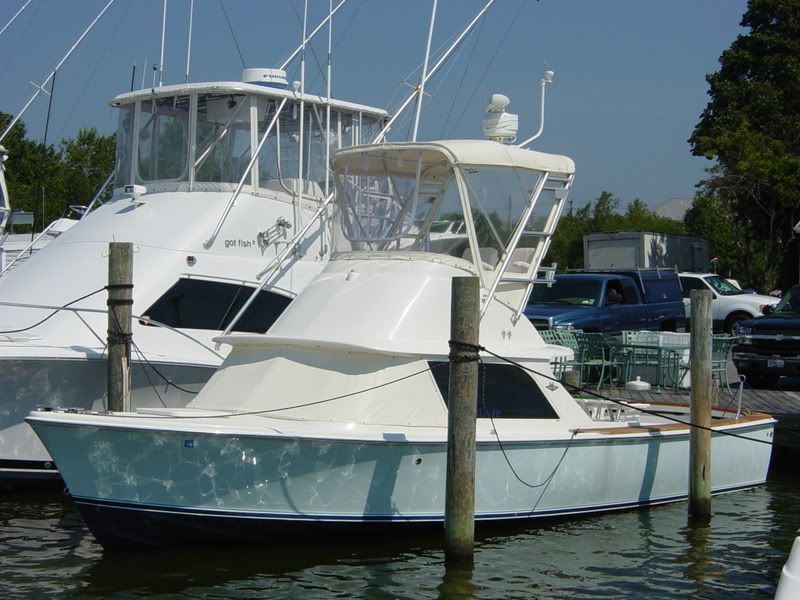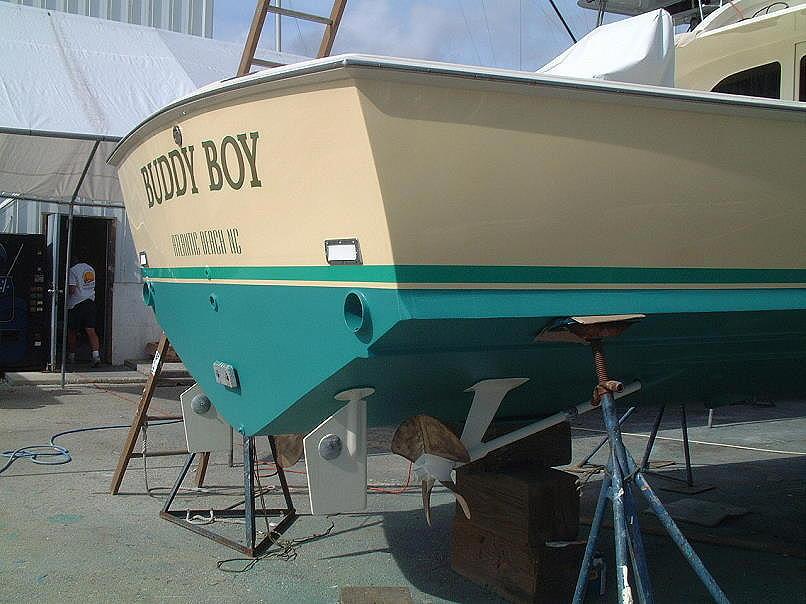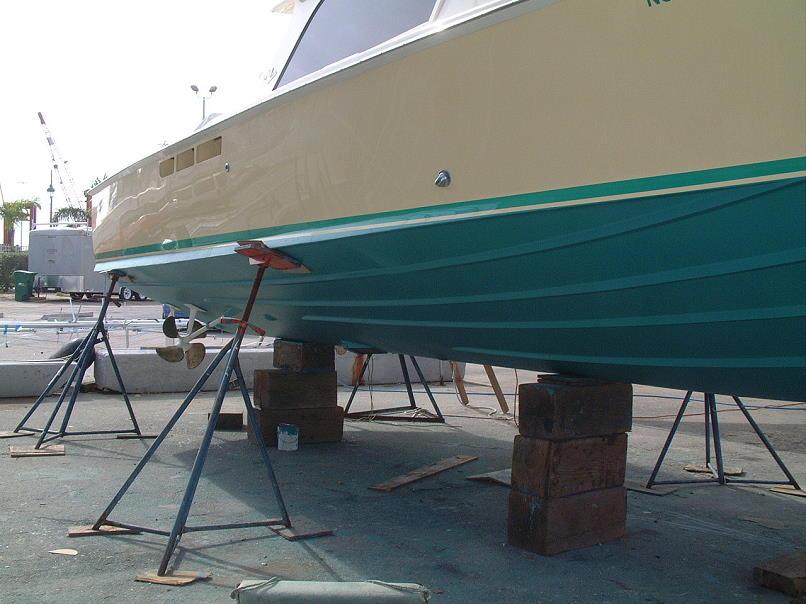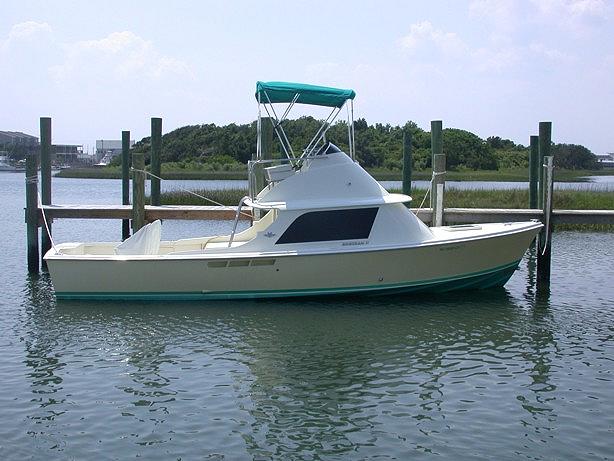Page 1 of 1
Posted: Aug 31st, '07, 07:34
by CaptPatrick
John,
It depends on how your boat will be loaded...
If, for example, you have a early model with 173 gallon tank, gas engines, no generator, & not rigged for heavy offshore tuna fishing, your boat will ride, at rest, fairly high on the water, even fully topped off with fuel. In this case, you can safely follow the chine. Your bottom paint will lap over & up about 1/2" above the chine. From there your boot strip can start, or you can skip a space of about 1", (called an accent stripe), & then start your boot stripe. The boot stripe or accent/boot stripe combination usually measures 3".
If your boat will be heavily loaded, has a larger fuel tank, heavy diesel engines, generator, lots of fishing gear & other "stuff", it will likely rest much lower in the water. Here you'd want to test float & load the boat to better find the true water line. At the transom, your bottom paint would rise 1/2" above the true water line, follow the true water line forward until the chine is above the water, following then the chine, as above.
Test loading a floating boat should be done with approximately the same maximum weight & distribution as will be normally on the boat when docked, but not loaded for a heavy duty fishing trip, (coolers full of ice, crew, expendable supplies, etc).
Br,
Patrick
Posted: Aug 31st, '07, 09:20
by DRIFTER31
I would put it a little high to be safe. Last boat i had the stripe was within two in. of the waterline and boats waves in the bayou would scum up the area between stripe and bottom paint. Now when i do one from scratch i bring the bottom paint up about 3-4in.above waterline then skip 1in and apply bootstripe. It is a little high but from a distance it makes the hull look like it has less freeboard and sleeker.
Posted: Sep 9th, '07, 20:57
by John Jackson
What are the opinions on whether the boot stripe should follow the chine to the tip of the bow or follow the waterline?
Posted: Sep 9th, '07, 22:23
by randall
think it looks better if it follows the chine
Posted: Sep 10th, '07, 15:43
by Mikey
Agree with Randall, but with the heavy engines and big fuel tank can't follow the chine to the stern. Advice here (the yard) is to add weight to the bow (couple hundred lb's)bringing the bow down which I am told should bring the stern up. Is this true or are we barking at the moon? If it won't bring the stern up I don't necessarily want to add the weight.
Now, Randall, if it won't bring the stern up where do I draw the line, pun intended. I plan to leave about an inch of hull paint between the bottom paint and the boot stripe. Not sure I want to transition between the 'above' the chine at the stern and 'at' the chine further up. Won't that look strange? Anybody got good pictures of this on a boat with a normally heavy load?
Posted: Sep 10th, '07, 20:04
by bob lico
micky this is a fbc loaded; 330 cummins,generator,porcelein toilet and corian coun
ters,hot water heater,full array of tools,231 gallon fuel.keep all weight balance and add on extras to the rear off bulkhead.v-berth and saloon as light as possible

Posted: Sep 10th, '07, 20:20
by JP Dalik
I like the Yacht stripe which follow the water line. You should float her before guessing at it. I think the yacht stripe gives the bow a little more presence.
Most of the boats have a boot stripe which follows the chine. The bottom line is the boot stripe is easier to paint- face it all those lifting strakes play hell with a yacht stripe job. Like all of this its preference.
Have fun
Posted: Sep 10th, '07, 20:32
by CaptPatrick
Mikey,
"Buddy Boy" was heavy aft when full of fuel and very little gear forward of the engines. The bottom paint was raised aft to be 1" above the surface of the water when at rest and topped off.
The transition back to the chine was made just about below the lower corner of the curved windshield section. The taping was gently curved back up to make the transition spread over about a 4' reach.
In the water, you hardly notice it...



Posted: Sep 11th, '07, 07:48
by John Jackson
I saw some examples where the bottom paint went up over the chine and it did not come out as good as the Buddy Boy. On my boat I put the boot stripe along the chine. When I am fully loaded with fuel about an inch of the chine is underwater and my exhausts are 3/4 submerged. I have a teak deck, diesel engines, four batteries, a hard top and 245 gallons of fuel so I guess my boat is on the heavy side of average. When I get down to around 100 gallons the chine is all the way out of the water and almost all of the exhaust holes are clear of the water. What I do is usually keep my tank between 1/2 and 1/4 and only fully load up when I am going to run for a few hours the next day or right after. With the diesel engines this gives plenty of range so I am not constantly at the fuel dock. Otherwise, if it has to sit for a while full of fuel you just hit the chine every other day with the soft brush and it stays clean. The parts that get wet & weedy are easy to reach and keep clean. By comparison I have a 17 foot Montauk and the bottom paint under the bow is too close to the water and reaching and cleaning underneath the tri hull style bow is a major pain in the neck. And shoulders.
I guess in addition to looks you should consider if you will keep your tank topped off and if you will leave the boat unloved at the dock for extended periods.



